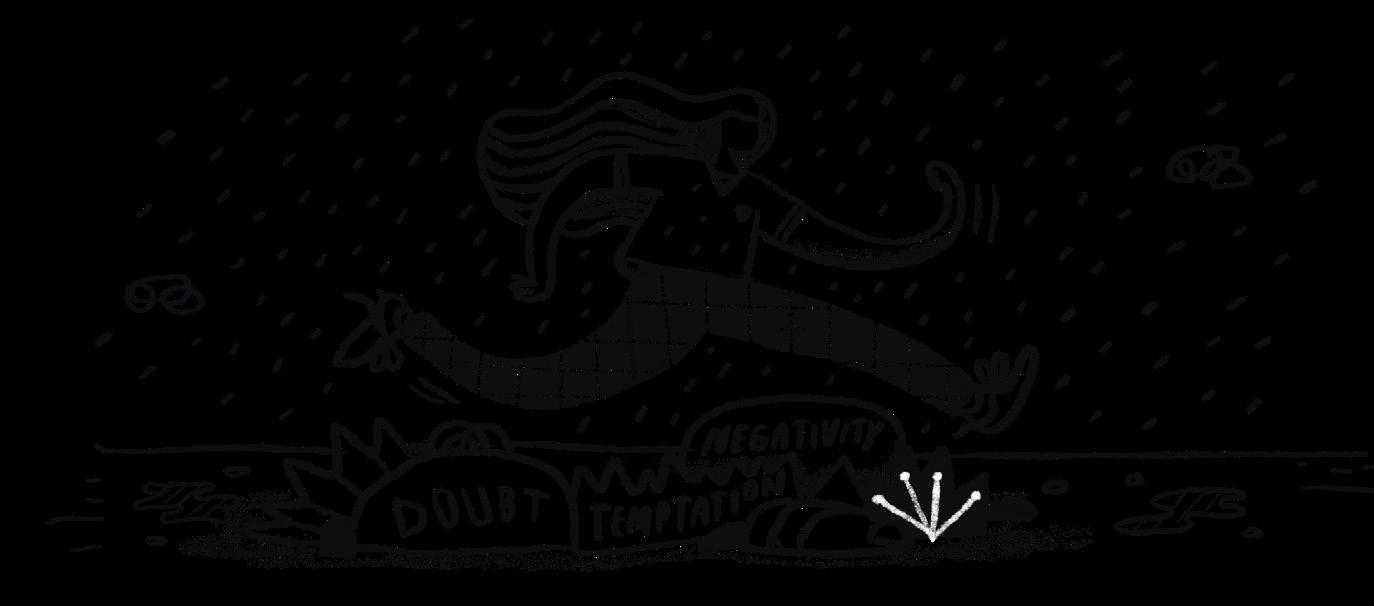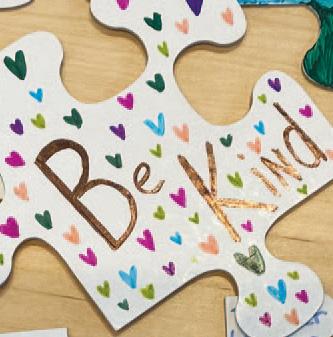Wellbeing
© The Examcraft Group | Reproduction not permitted


You are a VIP - a very important

So take care with self-care. If not you, who? If not now, when?
– Toni Hawkins

© The Examcraft Group | Reproduction not permitted


You are a VIP - a very important

So take care with self-care. If not you, who? If not now, when?
– Toni Hawkins

Unfortunately, negative things happen to everyone in life; however, some people seem to bounce back quicker than others. This is referred to as resilience — your ability to bounce back after setbacks.
One useful way of understanding how to develop resilience is to use the acronym BOUNCE.
Bad things and times happen, but things do get better. Others are there to help you, but you need to let them know. Unhelpful thoughts don’t make things better. Nobody is perfect.
Concentrate on the good things in your life, it’s not all bad. Everybody has setbacks or struggles. You are not on your own here.
Here are five useful ways that you can build your own personal resilience. In the space provided, identify one way you could incorporate each one into your own life!





To fully understand the importance of being healthy, you will now have the opportunity to learn about physical and mental health and the impact both have on your overall wellbeing.
One way that you can look after your physical health is by eating a balanced diet, getting sufficient sleep and doing some exercise each day. Good diet, sleep and exercise have countless physical and mental benefits.


• Helps to build and maintain healthy bones, muscles and joints
• Helps to control weight, build lean muscle and reduce fat
• Prevents and reduces high blood pressure
• Improves your memory and lengthens your attention span
• Improves your decision-making, planning and multi-tasking skills
• Increases your production of new nerve, blood and brain cells

Ensure you have a healthy diet.

Scan this bar code to access the food pyramid, which shows how often you should eat different food groups.

Ensure you get a good night’s sleep. Avoid being on a screen before you go to bed, and it’s best not to bring your phone into your bedroom.

Try to get the daily recommended physical activity of 30 minutes of exercise. Consider including a column for physical activity in your study timetable so you can actively make it part of your daily routine.
The most important thing about mental health is being aware of your feelings as they arise. This helps you identify stress triggers and how you react to them. It is important that you have people around you that you can talk to about these things.
assistance advice support
So, let’s identify people in your life that you can go to in the three categories below.


People in your life with whom you can talk about anything.
People in your life who you can go to for advice.
1 2 3 1 2 3
Names of agencies / support services available to you if you need them.
In the diagram below, fill in each circle with the various people in your life.

We all handle our feelings in different ways.


That’s why it’s useful to have a list of things that make us feel happy or calm. Then, if we’re feeling low, we can just look at our list and pick something to try. This way, we have a “toolkit” ready whenever we need it!
What’s in your self-care toolkit?
What works to lift one person up might not be the right thing for someone else. When we’re stressed or overwhelmed, it can sometimes feel too hard to even think of what might help us feel better. 3 7 4 8 1 5 2 6

The Focus Finder helps you focus on what’s within your power to change, so you can let go of unnecessary worries and feel more at ease.
By letting go of what’s outside your control, you’ll be able to set more realistic goals, reduce stress and make your time and effort count.

Once you have filled in the circles, you will clearly see what is within your control and what’s not. Create a plan of action to address what’s in the inside circle and then practise letting go of what’s in the outside circle – as it is not within our control, we cannot change this.

mycontrol my control
• My attitude
• My reactions
• My self-care
• My work ethic
• How I spend my time
• Asking for help
• My words
• Social media accounts I follow
• My commitments


• What people say/ do
• Others’ opinions
• Weather
• The future
• The past
• Decisions I made in the past
• How others react





The more you practise, the quicker you’ll be able to re-establish calm in your body and mind during stressful times. It makes sense that we take time to practise activating this response, so we can re-establish a sense of calm when we need it, like during a class test.
Start here
SO, HOW CAN WE DO IT?
STEP 1
Sit up straight and uncross your arms and legs.
STEP 2
Inhale slowly through your nose, counting silently to 4.
STEP 3
Hold your breath, counting to 4.
STEP 4
Exhale slowly through your mouth, counting to 4.
STEP 5
Hold again for 4.
STEP 6
Repeat 3 to 5 times or until you feel calm.

Would you add this to your self-care toolkit?
Time to focus on something chill.
Mindful colouring is a great way to reset — it’s just the right mix of fun and calming. If you’re feeling stressed, bored or anxious, give it a try.

Colouring helps you to refocus when feeling overwhelmed. Sometimes a little break is all you need to see things more clearly.


• Never cycle in the dark without adequate lights.
• Wear a reflective jacket, armbands and belt if cycling at night.
• Obey traffic signs and signals and watch out for traffic.
• Ensure your bike is in working order.
• Keep to the left.
• Wear a helmet.
• Do not wear headphones.
• Take your time.
• Always walk facing traffic so that a car can’t come up behind you.
• Don’t cross the road on a corner or a bend.
• Don’t walk on dark roads on your own at night – stick to walking in daylight.
• Always walk on the footpaths.

Take a moment to reflect on kindness in your life. Answer the following in a few sentences:
A time someone was kind to me (What happened? How did it make me feel?):
A small way I can show kindness every day:
Bullying is targeted and repeated behaviour— relationships between two people or groups of people.

While one incident may not be bullying, aggressive behaviour is not acceptable in any school. Let’s remember the Golden Rule: treat others as you’d like to be treated.
Disagreements or deciding that you don't want to be friends anymore is not bullying. However, if someone repeatedly tries to harm, exclude, or turn others against someone, that is bullying. Online, a hurtful post can feel like bullying if it spreads and continues to cause harm. If you’re feeling upset by someone’s behaviour, talk to a teacher or someone you trust—HELP IS ALWAYS AVAILABLE.


Create a set of illustrated scenarios showing different behaviours(both bullying and non-bullying).
( ) Tick if the situation is bullying.
( X ) Put an X if it is not bullying.
CLASS DISCUSSION – Review the answers together and discuss why certain situations are considered bullying and others are not.
Example scenarios for pictures:
• Two friends argue and stop talking for a day
• A student accidentally bumps into someone in the hallway
• Someone disagrees with a classmate in a group discussion




Below are some phrases to help you use your voice to challenge harmful and hateful words.

Let’s change the topic? I don't feel comfortable with this conversation."
It’s not a joke when it hurts people; let's treat everyone with respect."
I don't think it's fair to make fun of someone for who they are or where they come from."
I'm here for you. I’m sorry people have treated you this way. If you need support, I've got your back."
Listen to the song ‘Titanium’ by David Guetta and Sia.

Record below what you feel the message of this song is:
The opposite of bullying isn’t just not being mean, it's actively choosing to be kind. It’s using your voice, your presence, your social media to create a world where people feel safe, valued, heard and seen. When we are kind the following happens:
endorphins, making receiver feel happier.
When you show kindness to another person, it creates a ripple effect. Not only does it make them feel good, but you feel good too. An extra bonus is that they’re more likely to pass that kindness on to someone else!
Complete the following random acts of kindness, and after each one, take a moment to notice how it feels.


89F Lagan Road, Dublin Industrial Estate, Glasnevin, Dublin 11, Ireland, D11 F98N.
info@examcraftgroup.ie www.examcraftgroup.ie 01-8081494